|
|
|
Sort Order |
|
|
|
Items / Page
|
|
|
|
|
|
|
| Srl | Item |
| 1 |
ID:
092839


|
|
|
|
|
| Publication |
2009.
|
| Summary/Abstract |
This paper investigates the potential for making deep cuts in US transportation greenhouse gas (GHG) emissions in the long-term (50-80% below 1990 levels by 2050). Scenarios are used to envision how such a significant decarbonization might be achieved through the application of advanced vehicle technologies and fuels, and various options for behavioral change. A Kaya framework that decomposes GHG emissions into the product of four major drivers is used to analyze emissions and mitigation options. In contrast to most previous studies, a relatively simple, easily adaptable modeling methodology is used which can incorporate insights from other modeling studies and organize them in a way that is easy for policymakers to understand. Also, a wider range of transportation subsectors is considered here-light- and heavy-duty vehicles, aviation, rail, marine, agriculture, off-road, and construction. This analysis investigates scenarios with multiple options (increased efficiency, lower-carbon fuels, and travel demand management) across the various subsectors and confirms the notion that there are no "silver bullet" strategies for making deep cuts in transport GHGs. If substantial emission reductions are to be made, considerable action is needed on all fronts, and no subsectors can be ignored. Light-duty vehicles offer the greatest potential for emission reductions; however, while deep reductions in other subsectors are also possible, there are more limitations in the types of fuels and propulsion systems that can be used. In all cases travel demand management strategies are critical; deep emission cuts will not likely be possible without slowing growth in travel demand across all modes. Even though these scenarios represent only a small subset of the potential futures in which deep reductions might be achieved, they provide a sense of the magnitude of changes required in our transportation system and the need for early and aggressive action if long-term targets are to be met.
|
|
|
|
|
|
|
|
|
|
|
|
|
|
|
|
| 2 |
ID:
116510
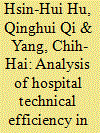

|
|
|
|
|
| Publication |
2012.
|
| Summary/Abstract |
This paper investigates the regional hospital efficiency in China during the 2002-2008 period, especially for how the health insurance reform of New Rural Cooperative Medical System (NRCMS) impacts on efficiency. Adopting the non-parametric technique of data envelopment analysis (DEA) to handle the feature of multiple outputs and undesirable outputs in the hospital industry, empirical estimates indicate that hospital efficiency is moderate that increased slightly from 0.6777 to 0.8098 during the sample period. However, it ranges widely from 0.396 to 1 across provinces. The regression analysis on examining determinants of efficiency suggests that a higher proportion of for-profit hospital and high quality hospital is helpful to enhance technical efficiency. We find a negative relationship between government subsidy and efficiency for coastal regions. While technical efficiency varies considerable across provinces, there is no significant difference between coastal and non-coastal regions being found, after controlling for other variables. Crucially, the medical reform of NRCMS overall has a significant efficiency-enhancing effect, particularly for non-coastal regions, ceteris paribus. It highlights the effectiveness of NRCMS on promoting medical service accessibility for rural residents.
|
|
|
|
|
|
|
|
|
|
|
|
|
|
|
|
| 3 |
ID:
171016


|
|
|
|
|
| Summary/Abstract |
This article analyses the defence industrial market using an agent-based model. The model draws a simplified version of the sector regarding the market agents and their conduct based on empirical data and commonly observed micro-regularities. Its computer implementation is initially tested on a simple scenario to verify its realism. Afterwards, some specific scenarios, caused by government industrial policies, are assessed. The main finding is the capability of the model to reproduce the behaviour of market agents and to replicate the evolution of the macroeconomic indicators and patterns normally seen under different, but common conditions and policies (e.g. free market, discriminatory procurement, licensed production or multilateral development and production). This suggests a powerful tool for gaining further insight and exploring government policies in this important economic sector.
|
|
|
|
|
|
|
|
|
|
|
|
|
|
|
|
| 4 |
ID:
168509


|
|
|
|
|
| Summary/Abstract |
Since it was founded in 1967, the Association of Southeast Asian Nations (ASEAN) has attracted both sceptics and proponents. With Southeast Asia’s economy growing rapidly and tied into all parts of the global economy and the region geopolitically important to the world’s major powers, how ASEAN manages its internal affairs and East Asian relations is crucial. The differences in how sceptics and proponents perceive ASEAN, and why they take up such contrasting positions, need to be fully appreciated as scholars and commentators review and assess ASEAN’s performance. This analysis uses three analytical criteria – effectiveness, legitimacy and efficiency – to juxtapose and evaluate the competing arguments of the two approaches so as to better understand how and why sceptics and proponents can examine the same institutions and events and reach very different conclusions.
|
|
|
|
|
|
|
|
|
|
|
|
|
|
|
|
| 5 |
ID:
170952
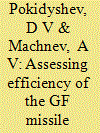

|
|
|
|
|
| Summary/Abstract |
The authors present the hierarchy analysis method as a means of assessing the efficiency of the Ground Forces (GF) Missile Forces control subsystem
|
|
|
|
|
|
|
|
|
|
|
|
|
|
|
|
| 6 |
ID:
152830
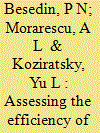

|
|
|
|
|
| Summary/Abstract |
The issue of assessing the efficiency of troop (force) command and control in combined-arms operations has always been topical, and apparently will remain to be so. It appears the most pressing whenever the army undergoes reformation, and also when one or another of the Armed Forces arms and services gets fundamentally reorganized to be up to their radically changed role and place in attaining objectives during a modern combined-arms operation, and also for the future prospect. However, publications on the matter, which could be said to boast considerable scientific and practical orientation, are few and far between. The reason, we think, is as follows.
|
|
|
|
|
|
|
|
|
|
|
|
|
|
|
|
| 7 |
ID:
098693


|
|
|
|
|
| Publication |
2010.
|
| Summary/Abstract |
In this study, efficiency analyses of the eleven lignite-fired, one hard coal-fired and three natural gas-fired state-owned thermal power plants used for electricity generation were conducted through data envelopment analysis (DEA). Two efficiency indexes, operational and environmental performance, were defined and pursued. In the calculation of the operational performance, main production indicators were used as input, and fuel cost per actual production (Y) was used as output (Model 1). On the other hand, in the calculation of the environmental performance, gases emitted to the environment were used as output (Model 2). Data envelopment analysis (DEA) is the main instrument for the measurement of relative performances of the decision making units with multiple inputs and outputs. Constant returns to scale (CRS or CCR) and variable returns to scale (VRS or BCC) type DEA models were used in the analyses. The relationship between efficiency scores and input/output factors was investigated. Employing the obtained results, the power plants were evaluated with respect to both the cost of electricity generation and the environmental effects.
|
|
|
|
|
|
|
|
|
|
|
|
|
|
|
|
| 8 |
ID:
090939
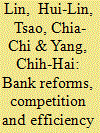

|
|
|
|
|
| Publication |
2009.
|
| Summary/Abstract |
This paper analyzes technical efficiency in China's banking system by large banks and small city banks as well as the pre-WTO and post-WTO accession periods. Using an unbalanced panel dataset for 63 banks over 1997-2006 and employing the stochastic frontier function approach, the empirical results reveal that the new entrants, small city banks, experienced a slightly higher efficiency score than incumbent large banks, on average. Compared with the pre-WTO accession period, the efficiency score is found to have improved significantly after entry into the WTO as a result of the competition effect. This competition effect is particularly relevant for small city banks. Finally, determinants of X-inefficiency are examined.
|
|
|
|
|
|
|
|
|
|
|
|
|
|
|
|
| 9 |
ID:
101086


|
|
|
|
|
| Publication |
2010.
|
| Summary/Abstract |
This paper examines the efficiency of the Thai banking sector from 1999 to 2008 by using the data envelopment analysis (DEA) method. The results indicate that inefficiency in the sector stems mainly from scale rather than pure technical efficiencies. The findings suggest that small banks are most efficient, while medium-sized banks have been the least efficient banking group. Domestic banks have been relatively more efficient than their foreign bank peers, which can be attributed largely to a higher pure technical efficiency (PTE) level. The results from the multivariate regression analysis suggest that banks with higher loans intensity and which are relatively better capitalised tend to exhibit higher efficiency levels. On the other hand, credit risk is negatively related to bank efficiency. The empirical findings suggest that the recent global financial crisis exerts a negative impact on the efficiency of Thai banks.
|
|
|
|
|
|
|
|
|
|
|
|
|
|
|
|
| 10 |
ID:
128423
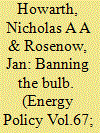

|
|
|
|
|
| Publication |
2014.
|
| Summary/Abstract |
Much academic attention has been directed at analysing energy efficiency investments through the lens of 'behavioural failure'. These studies have challenged the neoclassical framing of regulation which emphasises the efficiency benefits of price based policy, underpinned by the notion of rational individual self-mastery. The increasing use of a regulatory ban on electric lamps in many countries is one of the most recent and high profile flash points in this dialectic of 'freedom-versus-the-state' in the public policy discourse. This paper interrogates this debate through a study of electric lamp diffusion in Germany. It is argued that neoclassical theory and equilibrium analysis is inadequate as a tool for policy analysis as it takes the formation of market institutions, such as existing regulations, for granted. Further still, it may be prone to encourage idealistic debates around such grand narratives which may in practice simply serve those who benefit most from the status quo. Instead we argue for an evolutionary approach which we suggest offers a more pragmatic framing tool which focuses on the formation of market institutions in light of shifting social norms and political goals-in our case, progress towards energy efficiency and environmental goals.
|
|
|
|
|
|
|
|
|
|
|
|
|
|
|
|
| 11 |
ID:
079478


|
|
|
|
|
| Publication |
2007.
|
| Summary/Abstract |
We argue a case for a `revisioning' of the education policy-implementation nexus in the South African higher education sector. It is proposed that the well-meaning idealism expressed in policy pronouncements is necessarily subject to a host of mediations, national and international, which have a mutative effect on the original intent. This understanding of policy, as `policy pragmatism', is used to understand the discourse in current South African higher education, which although very `efficiency' driven, retains considerable access elements. The article describes how the initial policy intention of `unfettered' access transmutes to a pragmatic, cautious and guided right of entry. Thus, while initial policy propositions are contained in policy, they are not as overtly discernible as would be anticipated
|
|
|
|
|
|
|
|
|
|
|
|
|
|
|
|
| 12 |
ID:
139239


|
|
|
|
|
| Summary/Abstract |
This article builds on the contributions to this special issue by examining different approaches to the local turn and what can be learnt from applying them. The contributors agree on the imperative of understanding ‘the local’ in peacebuilding; however, there seems to be a multitude of ways forward in this regard. The immediate concern is how this acknowledgement translates into practices that allow for both efficiency and local emancipation in the building of peace. The article suggests giving up the ‘one-size-fits-all’ model of peacebuilding and engaging in context-based methods and research designs beyond generalisations. One way to go about this is to strive for interdisciplinary research – combining peace studies and political science with social anthropologists and area studies – but also to involve ‘the locals’ themselves in the process of taking a few methodological steps further.
|
|
|
|
|
|
|
|
|
|
|
|
|
|
|
|
| 13 |
ID:
185701
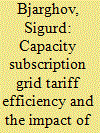

|
|
|
|
|
| Summary/Abstract |
While volume-based grid tariffs have been the norm for residential consumers, capacity-based tariffs will become more relevant with the increasing electrification of society. A further development is capacity subscription, where consumers are financially penalised for exceeding their subscribed capacity, or alternatively their demand is limited to the subscribed level. The penalty or limitation can either be static (always active) or dynamic, meaning that it is only activated when there are active grid constraints. We investigate the cost impact for static and dynamic capacity subscription tariffs, for 84 consumers based on six years of historical load data. We use several approaches for finding the optimal subscription level ex ante. The results show that annual costs remain both stable and similar for most consumers, with a few exceptions for those that have high peak demand. In the case of a physical limitation, it is important to use a stochastic approach for the optimal subscription level to avoid excessive demand limitations. Facing increased peak loads due to electrification, regulators should consider a move to capacity-based tariffs in order to reduce cross-subsidisation between consumers and increase cost reflectivity without impacting the DSO cost recovery.
|
|
|
|
|
|
|
|
|
|
|
|
|
|
|
|
| 14 |
ID:
115303
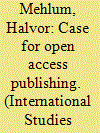

|
|
|
|
|
| Publication |
2012.
|
| Summary/Abstract |
This article presents some of the main efficiency and fairness arguments in favor of open access publishing. It discusses how general open access could affect research and editorial practice. It ends with a discussion of the feasibility of open access and how a move to open access publishing could happen.
|
|
|
|
|
|
|
|
|
|
|
|
|
|
|
|
| 15 |
ID:
167728


|
|
|
|
|
| Summary/Abstract |
This article addresses the problem of combat moral and psychological support system, characterizes its types, identifies ways of raising the efficiency of this trend, and describes the experience of displaying the servicemen's morale training level in combat actions.
|
|
|
|
|
|
|
|
|
|
|
|
|
|
|
|
| 16 |
ID:
152512


|
|
|
|
|
| Summary/Abstract |
This paper examines and compares the profitability of banks in the USA and China. The USA has the largest market-based banking system and the financial system of China is still bank-based. Our analysis indicates that in terms of profitability, banks in China outperformed those in the USA during our study period (2008–2014). Real estate loans had an adverse effect on US bank profitability during the financial crisis and no effect after the crisis but consistently improved the profitability of Chinese banks. Interest margins have no effect on US bank profitability but a consistently positive effect on Chinese banks, confirming that China is a traditional bank-based economy. Interbank loans have a positive and significant effect on Chinese bank profitability, while interbank domestic loans have a negative effect on US bank profitability. Finally, size had a positive effect on US banks after the financial crisis period, confirming the scale economies of large US banks, but a negative effect on Chinese banks, indicating diseconomies of scale.
|
|
|
|
|
|
|
|
|
|
|
|
|
|
|
|
| 17 |
ID:
113415


|
|
|
|
|
| Publication |
2012.
|
| Summary/Abstract |
This paper presents an analysis of the cost-effectiveness of high-efficiency appliances in the U.S. residential sector using cost and efficiency data developed as part of the regulatory process of the U.S. Department of Energy's Appliances and Commercial Equipment Standards Program. These data are presented as a case study in the development of an 'efficiency technology database' which can be expanded and published as a resource to other researchers and policy makers seeking scenarios that optimize efficiency policies and forecast their likely impacts on energy demand and greenhouse gas emissions. The use of this data to evaluate cost-effectiveness according to a variety of metrics is demonstrated using the example of one refrigerator-freezer product class. Cost-effectiveness is then evaluated in terms of cost of conserved energy for refrigerators, room air conditioners, water heaters, cooking equipment, central air conditioners and gas furnaces. The resulting potential of cost-effective improvement ranges from 1% to 53% of energy savings, with a typical potential of 15-20%.
|
|
|
|
|
|
|
|
|
|
|
|
|
|
|
|
| 18 |
ID:
107969


|
|
|
|
|
| Publication |
2011.
|
| Summary/Abstract |
This article experimentally studies punishment from unaffected third parties in ten different games. The authors show that third-party punishment exhibits several features that are arguably undesirable. First, third parties punish strongly a decider if she chooses a socially efficient or a Pareto efficient allocation and becomes the richest party as a result. Interestingly, this form of punishment is especially pronounced in women and more left-wing participants. Second, third parties punish strongly a decider if she chooses an equitable allocation and becomes the richest party as a result. Finally, third parties considerably punish passive parties who make no choice, especially if the latter are richer than the third party. Implications of these findings for social theory are discussed.
|
|
|
|
|
|
|
|
|
|
|
|
|
|
|
|
| 19 |
ID:
169753
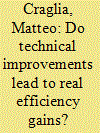

|
|
|
|
|
| Summary/Abstract |
Fuel economy standards are a key measure to increase the rate of efficiency improvements in passenger cars. The fuel consumption of vehicles can be improved in three ways: incremental technical efficiency improvements within powertrain technologies, market shifts to more efficient types of powertrains and by limiting increases in the size and performance of vehicles. This study quantifies the effect of each of these three drivers on the fuel consumption of British vehicles between 2001 and 2018 using driver-reported data on real-world fuel consumption. Analysis shows the introduction of EU fuel economy standards in 2008/09 had little effect on the rate of real technical efficiency improvements in British vehicles. Instead of adopting technical improvements at a higher rate or limiting the size and power of vehicles, these results suggest vehicle manufacturers met emissions standards by increasing the divergence between laboratory tests and real-world fuel consumption. This study adds to the growing literature calling for official test procedures to be representative of real-world driving.
|
|
|
|
|
|
|
|
|
|
|
|
|
|
|
|
| 20 |
ID:
168338


|
|
|
|
|
| Summary/Abstract |
I live in Burlington (pop. 43,600), state of Vermont (pop. 624,000), USA (pop. 326,000,000). We are the first U.S. city to become 100% renewable in electricity. We get hydro electricity from as far away as 700 km. (in Quebec, Canada) and as close as 1 km. Our wind electricity comes from sources 25–250 km distant. Our 50 MWe biomass plant burns forestry residues harvested within 160 km. Burlington now plans to become a “net-zero energy” city by 1. providing this renewable electricity (more) locally, and 2. extending coverage to present uses of fuel oil, petrol, and natural gas, with the notable exception of airplane fuel. This spatial reach has historically been de-emphasized in waves of enthusiasm for energy efficiency, sustainability (often loosely defined), and now renewability-especially in confronting greenhouse gas (GHG) emissions. I briefly review this history, and then present quantitative spatial impacts of Burlington's plans.
|
|
|
|
|
|
|
|
|
|
|
|
|
|
|
|
|
|
|
|
|